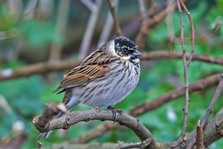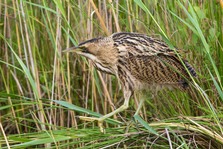

Biodiversity
Action
Plan
Breeding in Barnsley
Reed Bunting, S41, Amber
Reed Warbler, Green
Sedge Warbler, Green
Cetti’s Warbler. Schedule 1 Green
Bittern, Schedule 1, S41, Red
Bearded Tit, Schedule 1, Green
Marsh Harrier, Schedule 1, Amber
Bittern, smaller than the Heron, rarely seen, is camouflaged in shades of brown and buff with mottled markings.
The male’s booming call in spring is a sign of potential breeding.
At the time of the first BAP in 2002, Bittern was recorded as a passage migrant or occasional winter visitor.
Extensive reedbed habitat creation in the Dearne Valley by the RSPB, has encouraged Bittern to breed successfully from 2012.
Conservation measures
- Management & extension of Dearne Valley reedbeds
- Preventing degradation of existing reedbeds
- Creating new managed reedbed complexes
- Ensuring abundance of prey including by restocking
- Creation of ice-free areas and supplementary feeding during severe winter weather.
Habitats
- Reedbed
Bittern is dependent on large areas of reed in a freshwater habitat, with abundant fish and amphibians for breeding.
Reedbed edges with open water are needed to enable Bittern to forage for prey.
Harsh winter weather can bring about declines in numbers and local extinctions.
Without the reedbed habitat and an abundance of fish and amphibians, breeding Bittern would disappear from Barnsley.
Bittern
UKBAP 2007 Priority Species
NERC Section 41 Species of Principal Importance
BoCC5 Amber List [IUNC2 VU]
Schedule 1 W&C Act protection
Conservation measures
- Maintaining breeding and feeding habitats.
- Boost insect food by maintaining damp conditions,
- Leaving margins and ditch banks uncut or cutting on two or three-year rotations.
- Providing winter seed sources.
RSPB advice
Habitats
- Reedbeds and wetlands
- Well-vegetated water courses
- Damp areas of farmland
Reed Bunting, streaky brown, the male has a black head, white collar and drooping moustache.
It is fairly common but localised in Barnsley, with less than 300 breeding pairs.
It is found in reedbeds, wetlands, alongside water courses and in damp areas of farmland.
Adults eat a variety of insects and seeds. Chicks are fed almost exclusively on insects and spiders until they fledge.
Reed Bunting builds its nests low in dense vegetation, from grass, reeds and moss.
It breeds from April to July, with two to three broods.
Its decline has probably been caused by the reduction of damp habitats and food sources.
This has been caused by drainage, use of pesticides, the switch to autumn sown crops and loss of winter stubble.
There is a partial recent recovery.
Reed Bunting
UKBAP 2007 Priority Species
NERC Section 41 Species of Principal Importance
Amber List BoCC
General protection W&C Act
Reedbed birds. The creation and positive conservation of reedbeds in the Dearne Valley has led to Bittern breeding in 2012, Bearded Tit in 2017 and Marsh Harrier in 2020. Cetti’s Warbler, Reed Warbler and Sedge Warbler can also be found as can Reed Bunting which also frequents river banks and farmland. Cetti’s Warbler in fact is now common and wintering here.
Two reedbed birds are Local Priority Species: Bittern, now amber but previously red-listed because of its severe decline, and Reed Bunting, amber-listed. Both species are national priority species (UKBAP and Section 41).
The UK Breeding Water and Wetland bird populations indicator includes:
Cetti’s Warbler, Reed Bunting, Reed Warbler and Sedge Warbler.


Reedbed birds